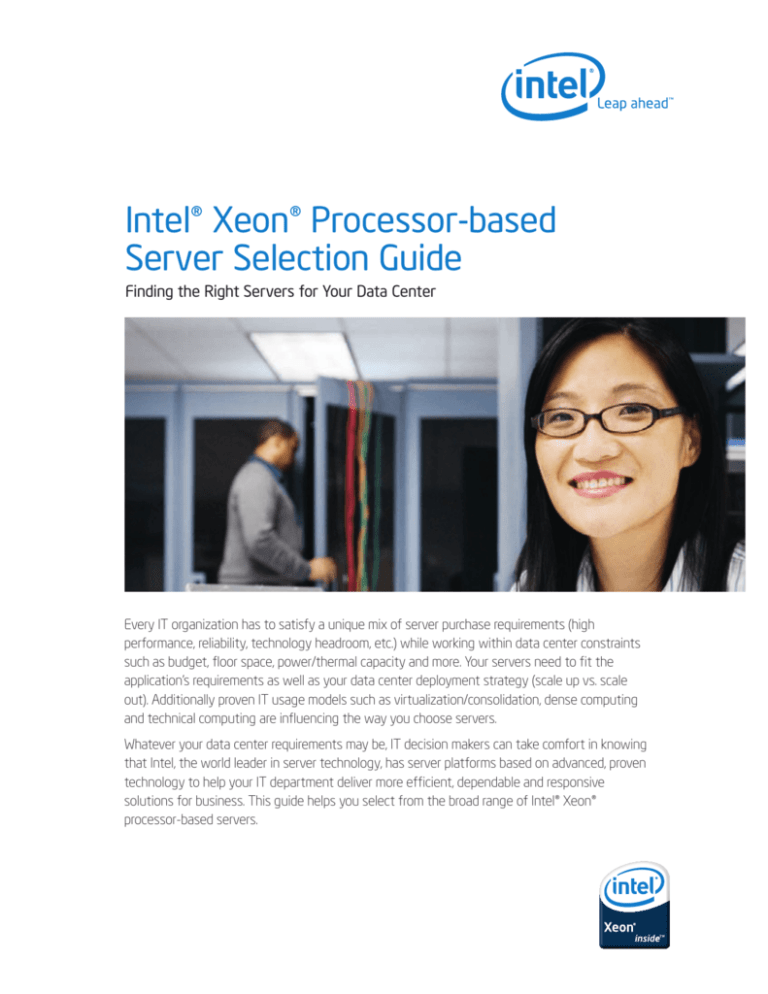
Intel® Xeon® Processor-based
Server Selection Guide
Finding the Right Servers for Your Data Center
Every IT organization has to satisfy a unique mix of server purchase requirements (high
performance, reliability, technology headroom, etc.) while working within data center constraints
such as budget, floor space, power/thermal capacity and more. Your servers need to fit the
application’s requirements as well as your data center deployment strategy (scale up vs. scale
out). Additionally proven IT usage models such as virtualization/consolidation, dense computing
and technical computing are influencing the way you choose servers.
Whatever your data center requirements may be, IT decision makers can take comfort in knowing
that Intel, the world leader in server technology, has server platforms based on advanced, proven
technology to help your IT department deliver more efficient, dependable and responsive
solutions for business. This guide helps you select from the broad range of Intel® Xeon®
processor-based servers.
The Intel® Xeon®
Processor Family
The breakthrough performance, energy efficiency,
and reliability of Intel Xeon processor-based server
systems make them the ideal choice for all of your
data demanding and standard enterprise infrastructure
applications, virtualization and consolidation projects or
high-density data center deployments. The Intel Xeon
processor family features:
Powerful, Flexible 64-bit Performance
Since 2004, Intel Xeon processor-based servers have provided leading
64-bit performance with the broadest 32-bit application support. Intel®
64 Technology+ future proofs IT investments by providing a seamless
migration path from existing 32-bit application environments to newer
64-bit environments.
Energy-efficient Multi-core Computing
Dual-Core Intel Xeon processors deliver a quantum leap in processing
capacity without a comparable increase in power consumption, enabling
businesses to grow their computing solutions more efficiently while
helping keeping data centers cool. And now the first Quad-Core Intel
Xeon processor-based servers are available, taking your data center to
a new level of performance within the same power envelope.
Intel Xeon processors are
designed to meet a variety
of business application and
data center requirements
2
Stable and Reliable
Intel Xeon processor-based systems are built with more server
reliability and advanced performance features than competitive
offerings, giving IT the headroom, reliability and compatibility you
need to keep pace with the changing business environment.
Intel® Xeon® Processors at a Glance
Dual-Core Intel® Xeon® Processor
5100 Series
Maximum price/performance for standard,
general-purpose applications where cost
is key priority
Advantages over
previous Intel-based
servers
Up to 3X more performance and more than
Best available performance/watt for a server:
3X power efficiency over previous single-core Get up to 50% more performance than Intel Xeon
Intel Xeon processor-based servers.i
processor 5100 series in the same power envelope.ii
Advantages over
Leading performance on 20+ standard
AMD Opteron*-based 2-way benchmark applications.
servers
Up to 48% more performance/chassisiv
and as much as 33% lower cost than
competing blades.v
Lowers power consumption up to 15%
versus AMD Opteron* dual-core processorbased servers.vi
IT Benefits
Quad-Core Intel® Xeon® Processor
5300 Series
Maximize performance/density and performance/
watt with the highest performance performance
available for 2-way servers running high-performing
infrastructure applications
Proactive data protection and improved
security through advanced redundancy
and error checking features.
Industry’s first quad-core technology further
extends Xeon’s performance/server and
performance/watt advantage over competing
servers at mainstream pricing.
Stable and reliable: Common technology platform
that scales from dual-core to quad-core featuring
more server reliability and advanced technology
features than competitive offerings.
Dual-Core Intel® Xeon® Processor
7100 Series
Maximum performance, reliability
and scalability available for standard
computing on data demanding applications
2.5x the performance and nearly 3 times
more performance per watt than the previous
Dual-Core Intel Xeon processor 7000 series,
supporting more users and data transactions
within a cooler data center.iii
Up to 1.5x better performance than the
competition with the help of the 16 MB
shared L3 cache.vii
More cache memory and threads per
processor than dual or competing multicore processors are ideal for demanding
applications in virtualized environments.
Up to 4x the system scalability enables better
performance for applications requiring reliable,
large-scale computing solutions.viii
Outstanding IT value with twice the cores
to enhance virtualization capacity and provide
higher data center density, at pricing similar to
dual-core platforms.
Most virtualization headroom in a 2-way platform:
Quad-Core Intel® Xeon® processor-based servers
effectively double the virtualization capacity
available in a dual-processor footprint, providing
more density and headroom for server virtualization
than any other 2-way standard high-volume
server platform.
Advanced redundancy and error checking
features such as memory mirroring and
sparing help proactively protect data
and improve security. Intel® Cache Safe
Technology allows continued operation
in the event of rare L3 cache errors.
Scalability, hardware-assisted virtualization,
and the broadest industry virtualization
software support combine to help optimize
data-center effectiveness.
Features
i
Large On-die cache
4 MB L2
8 MB L2
16 MB L3
CPUs
2
2
4-32
Cores/Threads
4/4
8/8
8-64/16-128
Memory Capacity
Up to 64 GB
Up to 64 GB
Up to 512 GB
I/O Capacity
3-4 slots PCIe*
3-4 slots PCIe*
7 slots (4P) PCIe* scalable to 48 slots2
Reliability
ECC, Memory RAS
ECC, Memory RAS
RAS PLUS Memory Hot Swap, Intel®
Cache Safe Technology
Based on measured SPECint_rate_base2000 results. Configuration details: Published/measured results as of Sept 21, 2006.
· Dual-Core Intel Xeon Processor 5160-based platform details: Dell PowerEdge* 2950 Server platform with two Dual-Core Intel Xeon Processor 5160, 3.00 GHz with 4M L2 Cache, 1333 MHz system bus,
8 GB (8x1 GB) FB-DIMM memory, Microsoft Windows Server* 2003 Enterprise Edition. SPEC binaries built with Intel C/C++ Compiler 9.1. Referenced as published at 123. For more information see
http://www.spec.org/cpu2000/results/res2006q2/cpu2000-20060501-05940.html
· Quad-Core Intel Xeon Processor-based platform details: Intel Server pre-production platform with two Quad-Core Intel Xeon Processor E5345, 2.33 GHz with 2x4M L2 Cache, 1333 MHz system bus, 8 GB (8x1
GB) FB-DIMM memory, Microsoft Windows* 2003 Enterprise Edition. SPEC‚ binaries built with Intel C/C++ Compiler 9.1.
ii
Data Source: Intel Internal measurement September 21, 2006. Performance chart compares an internal server side Java application benchmark measuring business operations completed per hour on pre-production platform with two Dual-Core Intel Xeon Processors 5160, 3.00 GHz (4M L2 Cache, 1333 MHz FSB, 8GB (8x1GB FB-DIMM memory) vs. two Quad-Core Intel Xeon Processors 53xx, 2.67 GHz with 2x4M L2
Cache, 1333 MHz system bus, 8 GB (8x1 GB) FB-DIMM memory.
iii
Data Source: Intel internal estimates or measurements as of September 21, 2006. Actual Results may vary. Buyers should consult other sources of information to evaluate the performance of systems or
components they are considering purchasing. For more information on performance tests and on the performance of Intel products, visit http://www.intel.com/performance/resources/limits.htm or call (U.S.)
1-800-628-8686 or 1-916-356-3104.
Continued on back page
More Server Choices from Intel
Basic Small Business Server
The Dual-Core Intel® Xeon® processor 3000Δ
series is ideal for first time small business
server computing needs. Intel's newest
dual-core processor for single-processor
servers, delivers a new level of energy-efficient
performance from the innovative Intel® Core™
microarchitecture, optimized for low-power,
dual-core, 64-bit computing.
Combined with the Intel® S3000 chipset family
and ECC DDR2 memory technology, the new
Dual-Core Intel Xeon processor 3000 seriesbased platforms are expected to deliver up to
3 times the performance and 3.5 times the
performance/watt of the Intel® Pentium® D
processor 950.4
Platforms based on the Intel Xeon processor
3000 series make it simple for small businesses
to get the reliability, availability and serviceability needed for server environments at an
economical cost.
4
Standard and Dense Infrastructure:
2-Processor Systems
The most widely deployed server architecture, Intel Xeon processorbased servers are proven capable of fulfilling the broadest range of
business needs across the data center, including e-mail, departmental
applications, Java application servers, financial and more. Servers based
on Dual-Core or Quad-Core Intel Xeon processor 5000Δ sequence offer
IT investment protection and deliver IT ultimate flexibility to adapt to
changing business needs through support for four generations of
processors on a single compatible technology platform. Featuring the
power-efficient Intel® Core™ microarchitecture with large on-die cache,
these processors offer powerful cost-effective computing solutions
while helping to keep the data center cool.
Quad-Core Intel® Xeon® Processor 5300Δ Series
The industry’s first quad-core processor,1 the Intel® Xeon® processor
5300 series provides breakthrough performance and capabilities
per watt for the ultimate in powerful, dense and energy-efficient
general-purpose servers.
Dual-Core Intel® Xeon® Processor 5100Δ Series
The Dual-Core Intel Xeon processor 5100 series offers industryleading dual-core server performance for cost-effective implementation
on a wide range of enterprise infrastructure applications.
Data Demanding:
4-Processor to 32-Processor Systems
More Server Choices from Intel
Intel® Xeon® processor 7000Δ sequence is your ideal choice for
New Dual-Core Intel® Itanium® 2 processor 9000Δ
series-based servers provide unmatched levels of
flexibility and scalability with demonstrated
mainframe-class reliability, proven performance,
for cost-effective computing compared to RISC
for your most critical business computing needs.
demanding enterprise applications and consolidation, where maximum
performance, scalability and reliability are critical deployment considerations. Servers built on the Dual-Core Intel Xeon processor 7000
sequence platform help your business become more agile while helping
to control data center costs.
Dual-Core Intel® Xeon® Processor 7100 Series
Δ
Servers built on the Dual-Core Intel Xeon processor 7100Δ series
designed specifically for multi-processor server platforms, deliver
scalable performance, hardware-assisted virtualization, and reliable
uptime for demanding enterprise workloads and business operations.
Dual-core 64-bit technology, added headroom plus Intel® Virtualization
Technology§ (Intel® VT), and advanced reliability features make this the
server of choice when you need the power to do more.
To learn more about Intel® Xeon®
processor-based servers go to
www.intel.com/products/processor/xeon
or speak to your local Intel reseller.
Mainframe-Class Computing
The new Dual-Core Intel Itanium 2 processor
9000 series delivers double the performance
of yesterday's processor, Intel® Cache Safe
Technology and Enhanced Machine Check
Architecture for increased availability and
reliability, hardware-assisted Intel Virtualization
Technology, Intel® Hyper-Threading Technology,◊
and 20 percent lower power consumption3.
Matching the Server to the Job and the Data Center
Selecting the right architecture and server platform for your data center pays dividends today, as well as over
time. Maximum IT value is achieved by balancing critical purchase criteria such as performance, cost, reliability,
and power to best fit your required applications and desired deployment model.
Step 1: What Do Your Applications Demand of Your Servers?
IT applications and the users who rely on them vary in their requirements for compute technology. Infrastructure applications such as
e-mail, networking, and office databases demand cost-effective capacity, while enterprise applications such as analytics and ERP require
higher performance and data bandwidth in the server. The first step in server selection is to select the most cost-effective server that
meets the needs of the application. The table below shows which Intel Xeon processor sequence offers the best value for
infrastructure and enterprise applications.
Requirement
Applications
Best Value
Data Demanding
Compute power and headroom for data
and transaction-intensive applications
• Enterprise databases
• Decision support
• Transaction-intensive applications
such as e-Commerce
• Business Intelligence (BI)
• ERP
• SCM
• CRM
Powerful enterprise Intel® Xeon® processor
7000 sequence-based servers
Standard Infrastructure
Cost-effective, easy-to-manage
performance and capacity for
standard business applications
• Mail and web
• Office or department databases
• Line-of-business applications
• Rendering farms
• Scale-out of financial service
and Java applications
• File/print
• Networking
• Application servers
• Technical computing
Versatile Intel® Xeon® processor 5000
sequence-based servers
Step 2: Optimize Data Center Value
Servers need to fit your data center deployment model and budget, as well as the applications that they host. The following table
matches Intel Xeon processor-based servers to data center needs:
Data Center
Requirement
Dual-Core Intel® Xeon® Processor 5100
Quad-Core Intel® Xeon® Processor 5300
Dual-Core Intel® Xeon® Processor 7100
Standardization
Standardize on Intel® Xeon® processors for the best mix of solutions across your standard infrastructure and data-demanding applications
Price/Performance
Best performance for standard,
high-volume server usage where
cost is key priorityi
Quad-core delivers the highest performing
dual-processor servers
Maximum data demanding application
performance and highest system
scalability
Performance/Watt
Intel® Core™ microarchitecture is
high-performance and easy to cool
Quad-core processors built on Intel® Core™
microarchitecture further boost power
efficiency in compatible thermal envelope
Significant gains over prior generation and
competitive performance/watt for high-end
server processing
Reliability
Genuine Intel architecture built with more unique reliability features than competitive offerings
Genuine Intel architecture with the
most reliability, availability and serviceability
(RAS) features for standard compute
environments
Deployment Model
Scale Out
Standard infrastructure applications and dense computing environments
Scale Up
Data demanding applications and
highly scalable computing environments
Dense Computing
Highly dense, low-cost blade and
rack solutions
Quad-core delivers maximum performance/
square foot for racks and blades
High-performance, scalable rack servers
Virtualization and
Consolidation
Consolidating standard web, e-mail
and other infrastructure applications
to boost utilization
2x cores and threads for
infrastructure consolidation
Maximum consolidation when peak
application performance, reliability and
memory capacity are critical
Good
Better
Best
More Server Choices from Intel
High-Performance Computing
(HPC) and Technical Computing
High-performance computing and technical
computing applications vary widely in their
response to different server architectures.
Intel Itanium 2 processor 9000 sequence:
Scalable performance featuring massive 64-bit
execution resources that are ideal for bio
simulation, climate research and other life
sciences applications. Providing support for
largest physical memory (up to 1 Petabyte),
memory bandwidth with proven scalability up
to 2,048-processesor symmetric multiprocessor (SMP) systems.
Intel Xeon processor 5000 sequence:
When high performance and performance/watt
for integer-intensive workloads are key considerations, powerful 64-bit dual-core and quadcore processor solutions meet the need.
Supporting both 32 and 64-bit applications
these servers are ideal for most technical
computing solutions including seismic modeling,
digital content, financial or design analysis, fluid
dynamics, life sciences and more.
Intel Xeon processor 3000 sequence:
For applications and deployments seeking
ultimate price/performance, best density and
competitive absolute performance. Small form
factor one-processor servers offer cost sensitive buyers great performance for 64-bit applications such as web farms and financial analysis
and for extending HPC into existing densitychallenged corporate structures.
7
www.intel.com/products/processor/xeon
Contacts
United States and Canada
Intel Corporation
Robert Noyce Building
2200 Mission College Blvd.
P.O. Box 58119
Santa Clara, CA 95052-8119
USA
Europe
Intel Corporation (UK) Ltd.
Pipers Way
Swindon
Wiltshire SN3 1RJ
UK
South America
Intel Semiconductores do Brasil LTDA
Av. Dr. Chucri Zaidan, 940-10° andar
04583-904 São Paulo, SP
Brazil
Asia-Pacific
Intel Semiconductor Ltd.
32/F Two Pacific Place
88 Queensway, Central
Hong Kong, SAR
Japan
Intel Japan (Tsukuba HQ)
5-6
Tokodai Tsukuba-shi
300-2635 Ibaraki-ken
Japan
Continued from page 8.
Source (AMD 940, AMD Opteron* 285 and Intel Xeon Processor 5100): Published or submitted results as of May 23, 2006. See http://www.intel.com/performance as of September 21, 2006. AMD Opteron*
socket F 2000 series publications as of September 20, 2006. Actual results may vary. Buyers should consult other sources of information to evaluate the performance of systems or components they are
considering purchasing. For more information on performance tests and on the performance of Intel products, visit http://www.intel.com/performance/resources/limits.htm or call (U.S.) 1-800-628-8686
or 1-916-356-3104.
v
Source (AMD 940, AMD Opteron* 285 and Intel Xeon Processor 5100): Published or submitted results as of May 23, 2006. See http://www.intel.com/performance as of September 21, 2006. AMD Opteron*
socket F 2000 series publications as of September 20, 2006. Actual results may vary.
vi
Measured by Principle Technologies* as of May 23, 2006. For configuration detail, go to http://principletechnologies.com/clients/reports/Intel/
vii
Performance measured using Intel internal TPC-C* SQL* 2005, SAP* SD, and SPECjbb* 2005 benchmarks. Intel internal, early platform measurements (17 July 2006) comparing system configurations of 4x
Intel® Xeon® Processor 7140M Platform, 3.40 GHz w/ 16M L3/ Intel® E8501Chipset / 800 MHz FSB to 4x Dual-Core Intel® Xeon® processors 3.00 GHz w/ 2x2M L2 / Intel® E8501Chipset/ 800 MHz FSB.
viii
Scalable to 32P dual-core versus 8P for Opteron* Model 8000.
For power reduction, TDP specification listed is compared between the prior generation and current generation Dual-Core Intel Xeon processor 7000 Sequence (7120M 95W vs. 7041 165W)[FJJ2].
Performance tests and ratings are measured using specific computer systems and/or components and reflect the approximate performance of Intel products as measured by those tests. Any difference in
system hardware or software design or configuration may affect actual performance. For further information see: http://www.intel.com/performance/server/xeon_mp/index.htm.
iv
1
Of standard, high-volume server processors.
2
Source 8-18-06 www.ibm.com. IBM eServer* Series x*460 configuration available through this website.
3
Principled Technologies June 2006. For configuration detail, go to http://principletechnologies.com/clients/reports/Intel/
4
Performance measured using SPECjbb* 2005 benchmark comparing to the Intel Pentium D processor 950 as of September 8, 2006. Performance per watt measured using WebBench* 5 benchmark comparing to
the Intel Pentium D processor 950 as of September 8, 2006
+
64-bit Intel® Xeon® processors with Intel® 64 architecture require a computer system with a processor, chipset, BIOS, OS, device drivers and applications enabled for Intel 64 architecture. Processor will not operate
(including 32-bit operation) without an Intel 64 architecture-enabled BIOS. Performance will vary depending on your hardware and software configurations. Intel 64 architecture-enabled OS, BIOS, device drivers
and applications may not be available. Check with your vendor for more information.
Δ
Intel processor numbers are not a measure of performance. Processor numbers differentiate features within each processor family, not across different processor families. See
www.intel.com/products/processor_number/ for details.
§
Intel Virtualization Technology requires a computer system with a processor, chipset, BIOS, virtual machine monitor (VMM) and applications enabled for virtualization technology.
Functionality, performance or other virtualization technology benefits will vary depending on hard-ware and software configurations. Virtualization technology-enabled BIOS and
VMM applications are currently in development.
◊
Hyper-Threading Technology requires a computer system with an Intel® processor supporting HT Technology and a HT Technology enabled chipset, BIOS and operating system.
Performance will vary depending on the specific hardware and software you use. See www.intel.com/homepage/land/hyperthreading_more.htm for additional information.
*Other names and brands may be claimed as the property of others.
Copyright © 2006 Intel Corporation. All rights reserved. Intel, the Intel logo, Intel. Leap ahead., Intel. Leap ahead. logo, Xeon, Intel Core, Pentium, Itanium, and the Intel
inside logo are trademarks or registered trademarks of Intel Corporation or its subsidiaries in the United States and other countries.
Printed in USA
1006/KW/OCG/XX/PDF
Please Recycle
315671-001US








